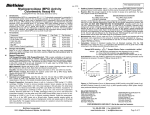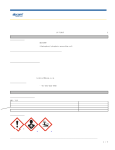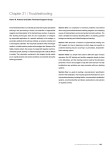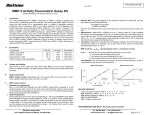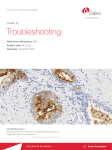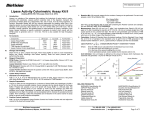Download data Sheet - BioVision
Transcript
BioVision Component MPO Assay Buffer MPO Substrate Stock MPO Probe Fluorescein Standard (1 mM) MPO Positive Control III. IV. K745-100 Cap Code Part Number 25 ml 50 µl 200 µl 50 µl 1 vial WM Blue Red Yellow Purple K745-100-1 K745-100-2 K745-100-3 K745-100-4 K745-100-5 Storage and Handling: Store the kit at -20°C and protected from light. Allow the Assay Buffer to warm to room temperature before use. Briefly centrifuge vials prior to opening. Read the entire protocol prior to performing the assay. Reagent Preparation: MPO Substrate: Mix 4 µl MPO Substrate Stock with 700 µl Assay Buffer to prepare the MPO Substrate Solution. MPO Positive Control: Reconstitute the MPO Positive Control with 50 µl Assay Buffer. Aliquot and store at -20°C. Use within one month. Avoid freeze thaw cycles. V. MPO Assay Protocol: 1. Standard Curve Preparation: Mix 5 μl of 1 mM Fluorescein Standard with 995 μl of Assay Buffer to prepare a 5 μM Fluorescein Standard solution. Add 0, 2, 4, 6, 8, 10 μl of 5 μM Fluorescein Standard solution into a series of wells. Adjust volume to 100 μl/well with Assay Buffer to generate 0, 10, 20, 30, 40, 50 pmol/well of Fluorescein Standard. Mix well. Read the Standard Curve at Ex/Em = 485/525 nm after 5 min. 2. Sample Preparations: Tissues or cells can be homogenized in 4 volumes of Assay Buffer and centrifuged (13,000 x g, 10 min) to remove insoluble material. Serum samples can be directly diluted in the Assay Buffer. Prepare test samples of up to 50 μl/well with Assay Buffer in a 96-well plate. For white blood cells, take 2 ml of blood and lyse RBC using RBC Lysis Buffer (Cat # 5831). Incubate for 10 min. at room temperature. Centrifuge at 400 x g for 5 min. and remove the supernatant carefully. Wash the pellet with 1 ml 1X PBS. Centrifuge at 400 x g for 5 min, and remove the supernatant carefully. Lyse the pellet using 200 µl MPO Assay BioVision Incorporated 155 S. Milpitas Boulevard, Milpitas, CA 95035 USA 3. Positive Control (optional): Add 10 µl of the reconstituted MPO Positive Control into Positive Control wells and adjust the volume to 50 µl/well with Assay Buffer. 4. Reaction Mix: Mix enough reagents for the number of assays to be performed. For each well, prepare a total 50 μl Reaction Mix: 46 μl MPO Assay Buffer 2 µl MPO Substrate Solution 2 µl MPO Probe Add 50 μl of the Reaction Mix to each well containing the Positive Controls and Samples. Mix well. (DO NOT ADD TO STANDARDS) 5. Sample Measurement: Read Ex/Em = 485/525 nm R1 at T1. Read R2 again at T2 after incubating the reaction at room temperature for 30 min (or longer time if the Sample’s activity is low); protect from light. The amount of RFU generated in the time interval T2 - T1 is ∆RFU = R2 - R1. It is recommended to read kinetically to choose the R1 and R2 within the linear range. Plot the Fluorescein Standard Curve and apply the ∆RFU to the Standard Curve to get B pmol of fluorescein (amount of fluorescein generated between T1 and T2 in the reaction wells). MPO activity can then be calculated: MPO Activity = Where: 𝐁 (𝐓𝟐−𝐓𝟏)× 𝐕 × Sample Dilution Factor = pmol/min/ml = μU/ml B is the fluorescein amount from the Standard Curve (in pmol). T1 is the time of the first reading (R1) (in min). T2 is the time of the second reading (R2) (in min). V is the pretreated sample volume added into the reaction well (in ml). One unit is defined as the amount of Myeloperoxidase that oxidizes the substrate to yield 1.0 µmol of fluorescein per minute at room temperature. 80000 2500 60000 2000 40000 20000 y = 1134.5x + 2163.8 0 MPO Activity (µU/mg) II. Introduction: Myeloperoxidase (MPO) is a peroxidase enzyme (EC 1.11.1.7) most abundantly present in neutrophil granulocytes. It is a green hemoprotein found in neutrophils and monocytes that catalyzes the reaction of hydrogen peroxide and halide ions to form cytotoxic acids and other intermediates that play a role in the oxygen-dependent killing of tumor cells and microorganisms. Its heme pigment causes the green color in secretions rich in neutrophils, such as pus and some forms of mucus. Furthermore, it can oxidize tyrosine to a tyrosyl radical using hydrogen peroxide as an oxidizing agent. In BioVision’s MPO Assay Kit, MPO catalyzes the production of NaClO from H2O2 and NaCl. Subsequently, NaClO will react stoichiometrically with Aminophenyl fluorescein (APF) to generate fluorescein, which can be detected at Ex/Em = 485/525 nm. The kit provides a rapid, simple, sensitive, and reliable method suitable for academic study and also high throughput assay of MPO activity. This kit can be used to detect MPO activity as low as 0.5 μU per well. Kit Contents: RFU (Catalog #K745-100; 100 assays; Store kit at -20oC) Buffer. Keep on ice for 10 min. Centrifuge at 10,000 x g for 10 min. to remove insoluble material. Collect the supernatant. Dilute the supernatant 10 times with MPO Assay Buffer and add 1- 10 µl of the diluted WBC lysate into a 96-well plate. Adjust the volume to 50 µl with Assay Buffer. We suggest testing several doses of your sample to make sure the readings are within the standard curve range. RFU Myeloperoxidase (MPO) Activity Fluorometric Assay Kit I. For research use only rev. 12/14 WBC Lysate Positive Control Blank 1500 1000 500 500 400 300 200 100 0 0 0 10 20 30 40 50 Fluorescein (pmol) 0 10 Time (min) 20 Figure: a) Fluorescein Standard Curve. b) Measurement of MPO activity in WBC lysate (0.1 µg), and MPO Positive Control (3 µl). c) MPO specific activity in WBC lysate. Assays were performed following the kit protocol. FOR RESEARCH USE ONLY! Not to be used on humans. Tel: 408-493-1800 | Fax: 408-493-1801 www.biovision.com | [email protected] Page 1 of 2 BioVision rev. 12/14 For research use only GENERAL TROUBLESHOOTING GUIDE: Problems Cause Solution Assay not working • Use of ice-cold assay buffer • Assay buffer must be at room temperature • Omission of a step in the protocol • Refer and follow the data sheet precisely • Plate read at incorrect wavelength • Check the wavelength in the data sheet and the filter settings of the instrument • Use of a different 96-well plate • Fluorescence: Black plates (clear bottoms) ; Luminescence: White plates ; Colorimeters: Clear plates • Use of an incompatible sample type • Refer data sheet for details about incompatible samples • Samples prepared in a different buffer • Use the assay buffer provided in the kit or refer data sheet for instructions • Cell/ tissue samples were not completely homogenized • Use Dounce homogenizer (increase the number of strokes); observe for lysis under microscope • Samples used after multiple free-thaw cycles • Aliquot and freeze samples if needed to use multiple times • Presence of interfering substance in the sample • Troubleshoot if needed • Use of old or inappropriately stored samples • Use fresh samples or store at correct temperatures until use • Improperly thawed components • Thaw all components completely and mix gently before use • Use of expired kit or improperly stored reagents • Always check the expiry date and store the components appropriately • Allowing the reagents to sit for extended times on ice • Always thaw and prepare fresh reaction mix before use • Incorrect incubation times or temperatures • Refer datasheet & verify correct incubation times and temperatures • Incorrect volumes used • Use calibrated pipettes and aliquot correctly • Use of partially thawed components • Thaw and resuspend all components before preparing the reaction mix • Pipetting errors in the standard • Avoid pipetting small volumes • Pipetting errors in the reaction mix • Prepare a master reaction mix whenever possible • Air bubbles formed in well • Pipette gently against the wall of the tubes • Standard stock is at an incorrect concentration • Always refer the dilutions in the data sheet • Calculation errors • Recheck calculations after referring the data sheet • Substituting reagents from older kits/ lots • Use fresh components from the same kit • Measured at incorrect wavelength • Check the equipment and the filter setting • Samples contain interfering substances • Troubleshoot if it interferes with the kit • Use of incompatible sample type • Refer data sheet to check if sample is compatible with the kit or optimization is needed • Sample readings above/below the linear range • Concentrate/ Dilute sample so as to be in the linear range Samples with erratic readings Lower/ Higher readings in Samples and Standards Readings do not follow a linear pattern for Standard curve Unanticipated results Note: The most probable list of causes is under each problem section. Causes/ Solutions may overlap with other problems. BioVision Incorporated 155 S. Milpitas Boulevard, Milpitas, CA 95035 USA Tel: 408-493-1800 | Fax: 408-493-1801 www.biovision.com | [email protected] Page 2 of 2


